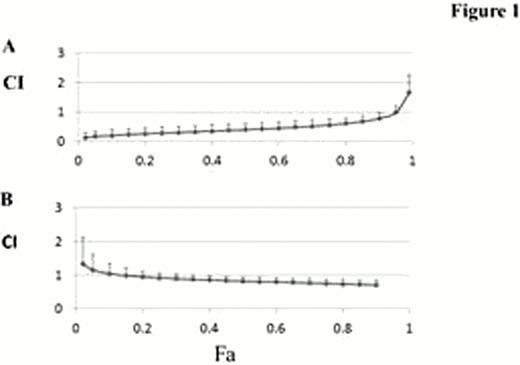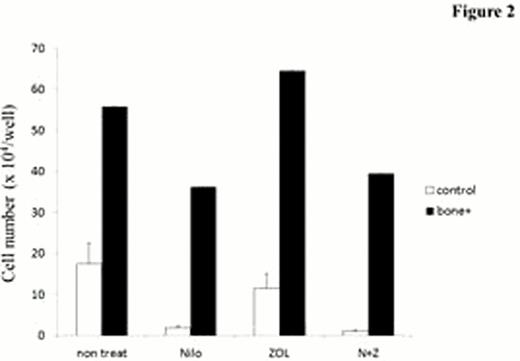Abstract
Abstract 2459
Prognosis of chronic myeloid leukemia (CML) has been dramatically improved by the induction of tyrosine kinase inhibitors (TKIs) as a first-line treatment. However, cure is still difficult because of the existence of leukemic stem cell (LSC).
Zoledronic acid (ZOL) is a 3rd-generation bisphosphonate that inhibits bone matrix resorption of osteoclasts (OCs), and inhibit the proliferation of several tumor cells by preventing posttranslational prenylation of Ras-related proteins. We have previously reported that ZOL possess anti-leukemic effect that augments synergistically the activity of imatinib mesylate (Kuroda, et al. Blood 2003), and OCs maintain leukemic cells in a quiescent state under newly developed co-culture system (Yokota, et al. Leuk Res 2010). Thus, we hypothesized that the treatment of ZOL combined with nilotinib (Nilo) may be effective to eliminate dormant leukemic cell population, called LSCs, by attacking the OCs. To test this hypothesis, we examined the combined effect of Nilo and ZOL on the human CML cell line BV173 and BaF3 cells expressing p190 wild type BCR-ABL (BaF3/BCR-ABL) in vitro.
Firstly, modified MTT assay was performed with ordinary condition (without any other co-cultured cells), resulting that ZOL augmented synergistically in vitro effects of Nilo both on cell lines (combination index < 1 at Fa=0.5) (Figure 1). Next we investigated the anti-leukemic effects of Nilo and ZOL using our developed co-culture system including osteoblasts (OBs), OCs and bone slices (Yokota, et al. Leuk Res 2010). 104 BaF3/BCR-ABL cells were applied to transwell chambers in each well of the co-culture plate (thus, BaF3/BCR-ABL cells did not attach directly to OBs, OCs and bones). Next day, each well was exposed to saline, Nilo 10nM, ZOL 10uM or Nilo 10nM plus ZOL 10uM. 48 hours after treatment, the viable cell number of BaF3/BCR-ABL was counted by trypan blue staining. Cell numbers were as follows; control: 55.79×104/well, Nilo only: 36.17×104/well, ZOL only: 64.46×104/well, Nilo plus ZOL: 39.42×104/well, respectively (Figure 2). These results suggested that combination effect of Nilo plus ZOL in vitro was canceled in the co-culture system. In the same condition, 7-AAD/Annexin V double staining was also performed. The apoptotic rates were as follows; control: 38.05 ± 2.36 %, Nilo only: 29.49 ± 2.59 %, ZOL only: 37.67 ± 1.39 %, Nilo plus ZOL: 29.66 ± 5.67 %. The results indicated that co-culture system of mimic the bone marrow microenvironment changed the drug effect on BaF3/BCR-ABL to resistance.
To reveal the mechanisms of this phenomenon, TGF-ƒÀ1 concentration in the co-culture supernatants was measured by ELISA. In the previous report, when BaF3/BCR-ABL were co-cultured with OBs, OCs and bone slices, their proliferation was significantly suppressed and TGF-ƒÀ1 was significantly higher in supernatants from the co-culture system consisted of OB+OC+bone than control. In the present study, TGF-ƒÀ1 ratios (TGF-ƒÀ1 concentration in each well administrated with each agent/that in the medium without any cells) were almost same among wells treated with each agent. These results suggested that TGF-ƒÀ1 concentrations maintained for a while even after OCs were destroyed by ZOL and the remained TGF-ƒÀ1 affected the effects of anti-cancer agents on the proliferation of CML cells.
In conclusion, the present study suggested that the evaluation of combined effects in ordinary culture system without any other cells which consist of microenvironment might not be correctly reflected in more physiological system. Therefore, it may be important to utilize the co-culture system used here to evaluate the effects of anti-cancer agents.
Combination effects of Nilo and ZOL evaluated in ordinary condition.
To examine the combined effects of Nilo with ZOL on (A) BaF3/BCR-ABL and (B) BC173, modified MTT assay was performed with ordinary condition (without any other co-cultured cells). The fraction affected (Fa) (i.e. Fa of 0.5 would equal 50% viable cells) and the combination index (CI) were calculated with CalcuSyn (Biosoft).
Combination effects of Nilo and ZOL evaluated in ordinary condition.
To examine the combined effects of Nilo with ZOL on (A) BaF3/BCR-ABL and (B) BC173, modified MTT assay was performed with ordinary condition (without any other co-cultured cells). The fraction affected (Fa) (i.e. Fa of 0.5 would equal 50% viable cells) and the combination index (CI) were calculated with CalcuSyn (Biosoft).
Combination effects of Nilo and ZOL evaluated in co-culture system.
Living cell numbers which were treated with saline (no treat), Nilo, ZOL and Nilo plus ZOL (N+Z) either in control culture system without any co-cultured cells (white bar) or co-culture system (black bar) were counted by trypan blue assay. Co-culture system consisted of osteoblasts, osteoclasts and bone slices.
Combination effects of Nilo and ZOL evaluated in co-culture system.
Living cell numbers which were treated with saline (no treat), Nilo, ZOL and Nilo plus ZOL (N+Z) either in control culture system without any co-cultured cells (white bar) or co-culture system (black bar) were counted by trypan blue assay. Co-culture system consisted of osteoblasts, osteoclasts and bone slices.
No relevant conflicts of interest to declare.
Author notes
Asterisk with author names denotes non-ASH members.



This feature is available to Subscribers Only
Sign In or Create an Account Close Modal